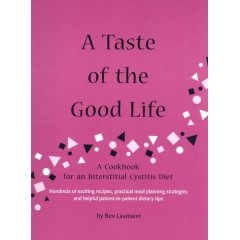Vitamin E and the IC Diet – Fresh Tastes by Bev
By Bev Laumann, Author of A Taste of The Good Life: A Cookbook for IC & OAB
Although not a cure-all, vitamin E’s ability to prevent oxidation has attracted much scientific interest (and a lot of press) lately. Free radicals are chemical by-products that are formed when your cells use oxygen. In the body, free radicals cause oxidation– a process which can damage cells and contribute to the aging process. Though not linked to IC, free radicals are linked to other health problems as diverse as cataracts, cancer, and arthritis.
Vitamin E is one of three antioxidant vitamins that perform a key role in neutralizing cell-damaging free radicals (the other two are beta carotene, which is a form of vitamin A, and vitamin C). These three vitamins appear to work best together. And if taken in pill form, they may work better when taken with a meal. Why? Because over millions of years our bodies evolved a process for taking in and using vitamins in combination with many other food substances. A deficiency or excess of one may impair the body’s ability to use others.
According to the American Dietetic Association, vitamin E deficiencies are rare, occurring mostly in people who can’t properly absorb fat. It’s easy for IC patients to get vitamin E in bladder-friendly foods but we shouldn’t be afraid to supplement our diets with a pil if need be. As a dietary supplement, preservative-free vitamin E is usually well tolerated by IC bladders. The Recommended Daily Allowance of vitamin E for adult men is 11 mg. (15 I.U.) and for adult women it’s 8 mg. (12 I.U.).
Vitamin E is a mild blood thinner, so if you are using other medications or IC treatments that have blood-thinning properties (i.e., heparin or Elmiron), you may want to check with your doctor before taking vitamin E supplements. (The dietary supplement L-arginine, an amino acid which helps some people’s IC symptoms, has also been found to have anti-blood clotting properties. For more information, see the study by A. Wolf, G. Zalpour et al., in the March 1, 1997 issue of Journal of the American College of Cardiology).
Luckily for those of us with IC, there is an abundance of bladder-friendly foods that supply vitamin E: pine nuts, wheat germ, sesame seeds, margarine, and vegetable cooking oils. Almonds and cashews ( if your bladder tolerates them) also supply vitamin E. One tablespoon of corn oil, for instance, supplies about one-quarter of a woman’s daily vitamin E needs. Green leafy vegetables such as spinach and lettuce supply small amounts of the vitamin too. (Women who have vulvar pain (vulvodynia) in addition to IC bladder troubles, may want to avoid the high-oxalate content of spinach and wheat germ. For them, the oxalates could trigger not only a bout of vulvar pain, but also a bladder flare-up.)
Finding baked products without preservatives in them can be difficult, so often I just make my own. These fresh homemade bread sticks are great when served warm from the oven with soups or Italian dishes. They have the added benefit of vitamin E from two good sources, olive oil and sesame seeds.
Easy Italian Bread Sticks
– makes 9
- 1/2 cup warm water
- 1 tsp. dry yeast
- 1-1/4 cups all-purpose flour
- 1/4 tsp. salt
- 1/2 tsp. sugar
- 1/2 tsp. dried oregano
- 1 Tbsp. olive oil
- 1 egg white
- 2 tsp. sesame seeds
- In a small dish stir dry yeast into the warm water (120 to 130 degrees F. – – warm to the wrist). Set aside about 5 minutes. Meanwhile, in a medium-sized bowl combine about half a cup of the flour with the salt, sugar and oregano; mix together well. Stir in the oil and softened yeast. By hand, gradually add the remaining flour to make a firm dough (may be a bit more or less than given amount).
- Knead on a lightly floured surface about six or seven minutes. Place in an oiled bowl and lightly oil top of dough. Cover and let rise in a warm place (80 to 85 degrees F.) until double in volume, about 40 minutes.
- Preheat oven to 400 degrees F. Punch dough down and divide in thirds. Divide each third into three pieces. Roll each piece into a rope about 7 inches long. Place about an inch apart on a non-stick or greased cookie sheet. Brush tops of bread sticks with egg white. Sprinkle with sesame seeds.
- Bake at 400 degrees for 17 to 20 minutes until golden brown on top. Remove and cool slightly before serving. Good served with Linguine with White Clam Sauce (see Fresh Tastes, Apr. 98).
Per bread stick: 85 calories, 2 g. total fat, 0 g. cholesterol, 1 g. fiber
——————
REFERENCES:
The Nutrition Desk Reference, 3rd ed.; R. Garrison, E. Somer; Keats Publishing; 1995

